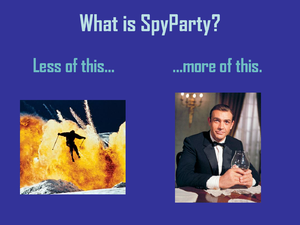m |
m |
||
| Line 8: | Line 8: | ||
* I claimed games are at about [http://en.wikipedia.org/wiki/Category:1905_films 1905] in terms of the history of film, making anologies between current games and '''deep and important works''' like [http://en.wikipedia.org/wiki/The_Misadventure_of_a_French_Gentleman_Without_Pants_at_the_Zandvoort_Beach The Misadventure of a French Gentleman Without Pants at the Zandvoort Beach] and [http://en.wikipedia.org/wiki/The_Little_Train_Robbery The Little Train Robbery] (aka. The Great Train Robbery 2: This Time With Kids!) | * I claimed games are at about [http://en.wikipedia.org/wiki/Category:1905_films 1905] in terms of the history of film, making anologies between current games and '''deep and important works''' like [http://en.wikipedia.org/wiki/The_Misadventure_of_a_French_Gentleman_Without_Pants_at_the_Zandvoort_Beach The Misadventure of a French Gentleman Without Pants at the Zandvoort Beach] and [http://en.wikipedia.org/wiki/The_Little_Train_Robbery The Little Train Robbery] (aka. The Great Train Robbery 2: This Time With Kids!) | ||
* I lauded Ico's hand holding mechanic, [[Potential Unreached|again]]. | * I lauded Ico's hand holding mechanic, [[Potential Unreached|again]]. | ||
* I whipped out the Korean characters for Gosu, 고수. | * I whipped out the Korean characters for [http://en.wikipedia.org/wiki/Gosu Gosu], 고수. | ||
* I outlined two approaches to creating games with more emotional depth: ''top-down'' and ''bottom-up'', and I discussed why I think ''bottom-up'' is a better approach. '''Games need to be able to communicate with players using a wider and deeper set of emotions.''' Just like film and music communicate emotionally in completely different ways, but are both incredibly deep, I think games will be as different from other art and entertainment forms as they are from each other, but we have a long way to go.<br/><center>[[Image:emodepth.png|300px]]</center> | * I outlined two approaches to creating games with more emotional depth: ''top-down'' and ''bottom-up'', and I discussed why I think ''bottom-up'' is a better approach. '''Games need to be able to communicate with players using a wider and deeper set of emotions.''' Just like film and music communicate emotionally in completely different ways, but are both incredibly deep, I think games will be as different from other art and entertainment forms as they are from each other, but we have a long way to go.<br/><center>[[Image:emodepth.png|300px]]</center> | ||
* I answered questions for longer than the actual lecture! | * I answered questions for longer than the actual lecture! | ||
Revision as of 17:54, 26 March 2011
I gave a talk at UC Berkeley called Design, Games, & Game Design (feat. SpyParty). It was for the UC Berkeley School of Information's Design Futures Lecture Series, and I was invited by the excellent Elizabeth Goodman.
The talk was a mix of general design stuff, game design stuff, and SpyParty design stuff. Among other things...
- I talked about the basic design → build → test loop, and how I don't think you can separate out the design and build steps if you're making something deep and new and (especially) interactive. I mentioned how Valve doesn't hire single-discipline designers for this reason.
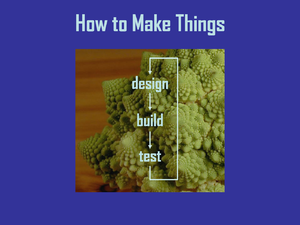
- I went over three kinds of user tests, depth testing, kleenex testing, and focus testing, and how you should never do the last one of those.
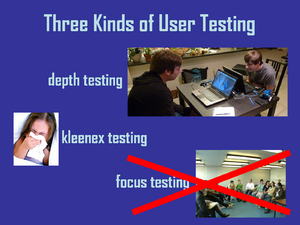
- I talked about Metrics Fetishism again; since this was a Design talk, it seemed appropriate.
- I claimed games are at about 1905 in terms of the history of film, making anologies between current games and deep and important works like The Misadventure of a French Gentleman Without Pants at the Zandvoort Beach and The Little Train Robbery (aka. The Great Train Robbery 2: This Time With Kids!)
- I lauded Ico's hand holding mechanic, again.
- I whipped out the Korean characters for Gosu, 고수.
- I outlined two approaches to creating games with more emotional depth: top-down and bottom-up, and I discussed why I think bottom-up is a better approach. Games need to be able to communicate with players using a wider and deeper set of emotions. Just like film and music communicate emotionally in completely different ways, but are both incredibly deep, I think games will be as different from other art and entertainment forms as they are from each other, but we have a long way to go.
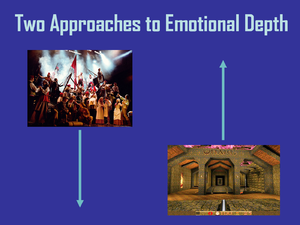
- I answered questions for longer than the actual lecture!
|
I also spent some time talking about my aesthetic goals for SpyParty, which include:
|
And, I talked more about the Blizzard-inspired Depth-first, Accessibility-later development model I'm following, including forcing people to read the four-page instruction manual before they can play.
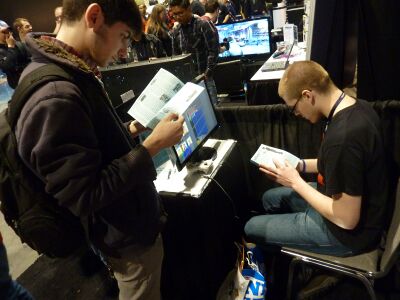
Here are the synced audio and slides, with 40 minutes of Q&A at the end:
Also, Tom Curtis was there and wrote about the lecture at Gamasutra.
And, because one cannot get enough of Fred Ott's Sneeze:





